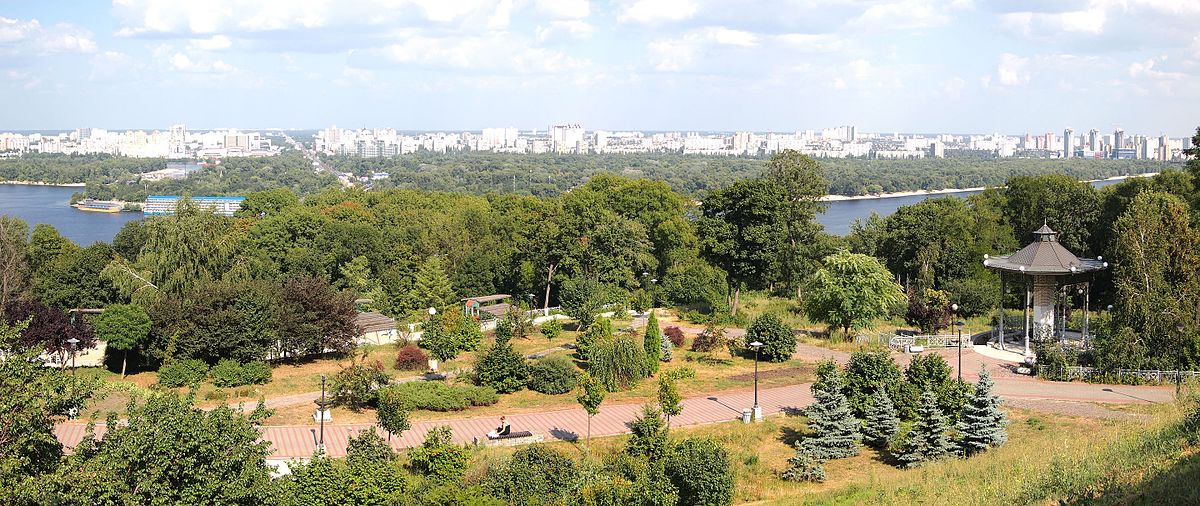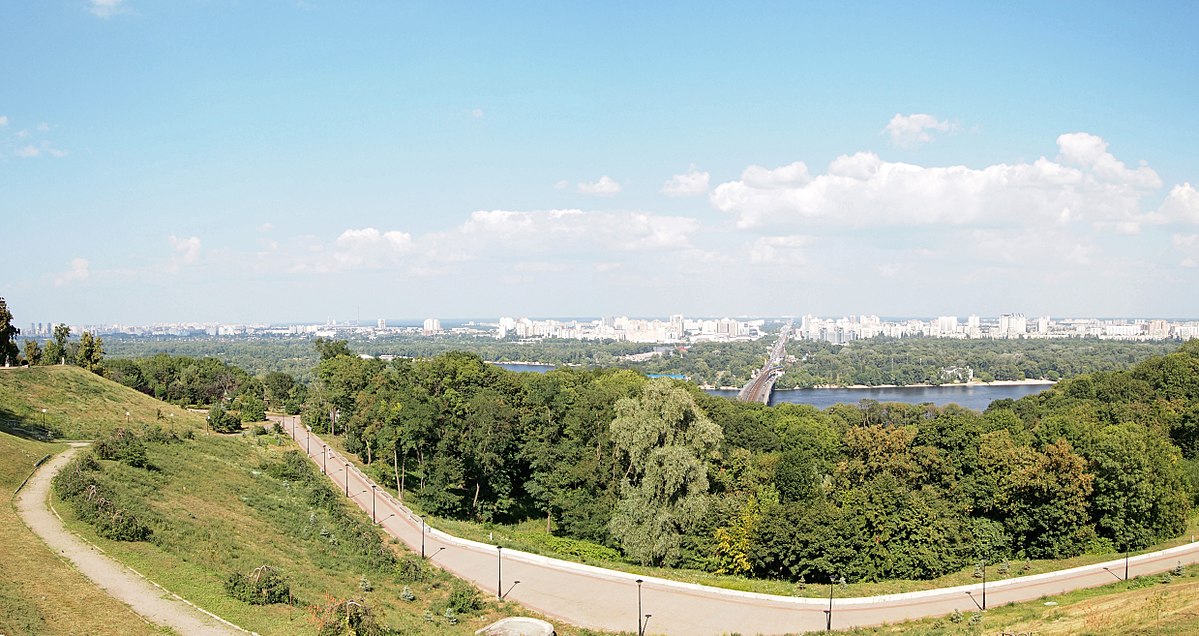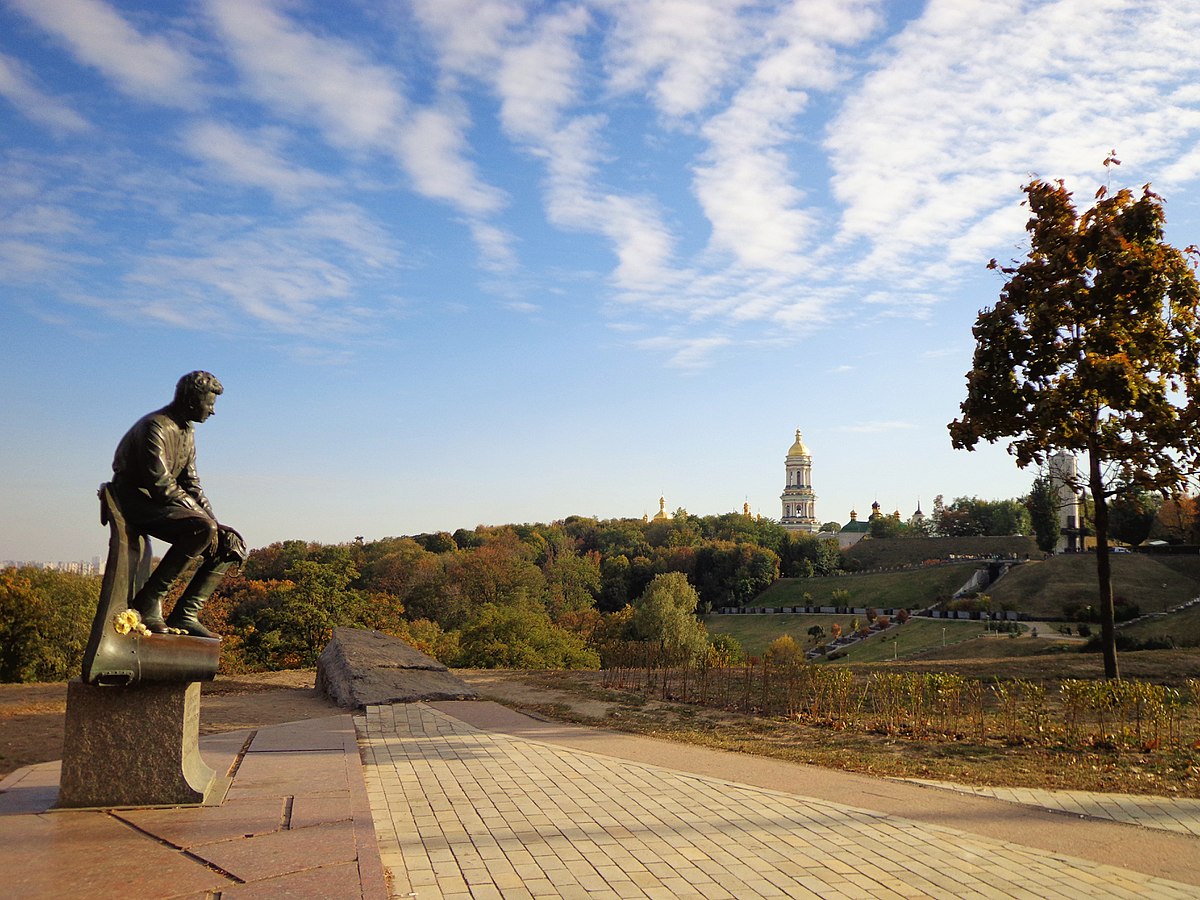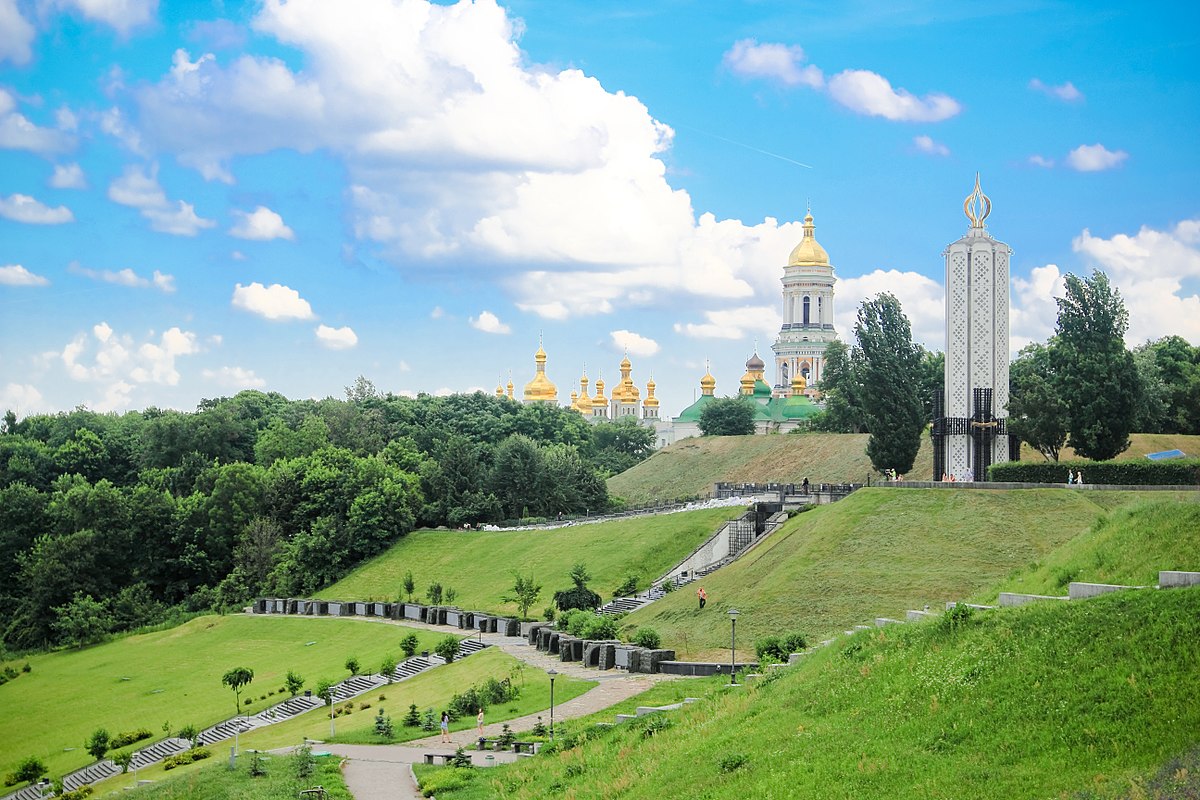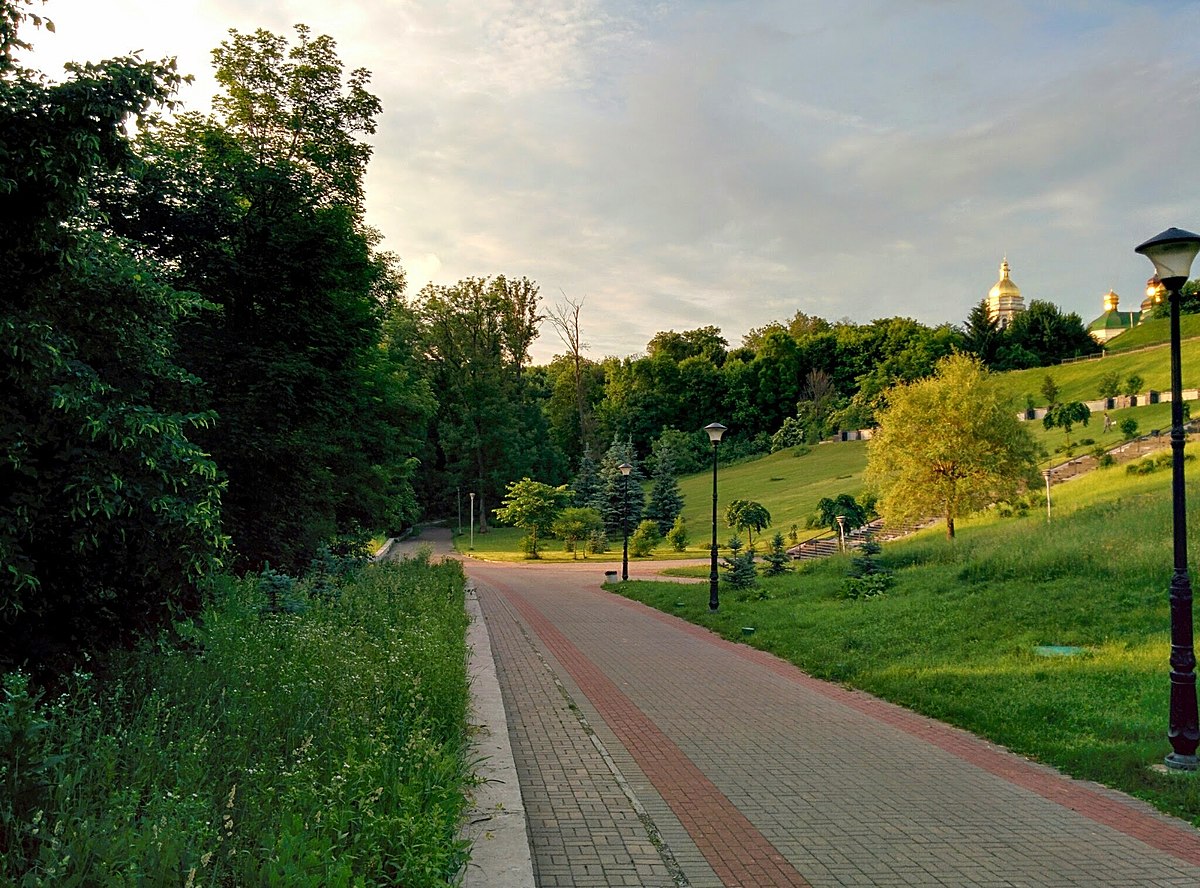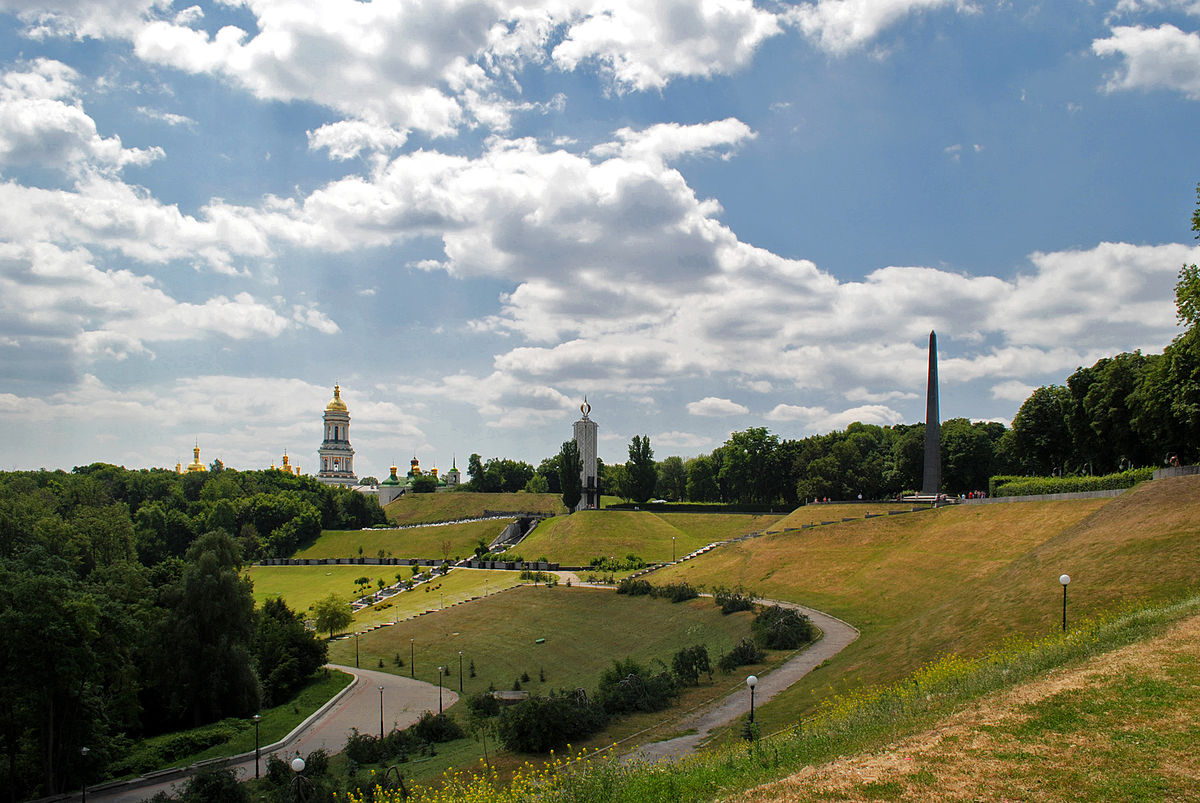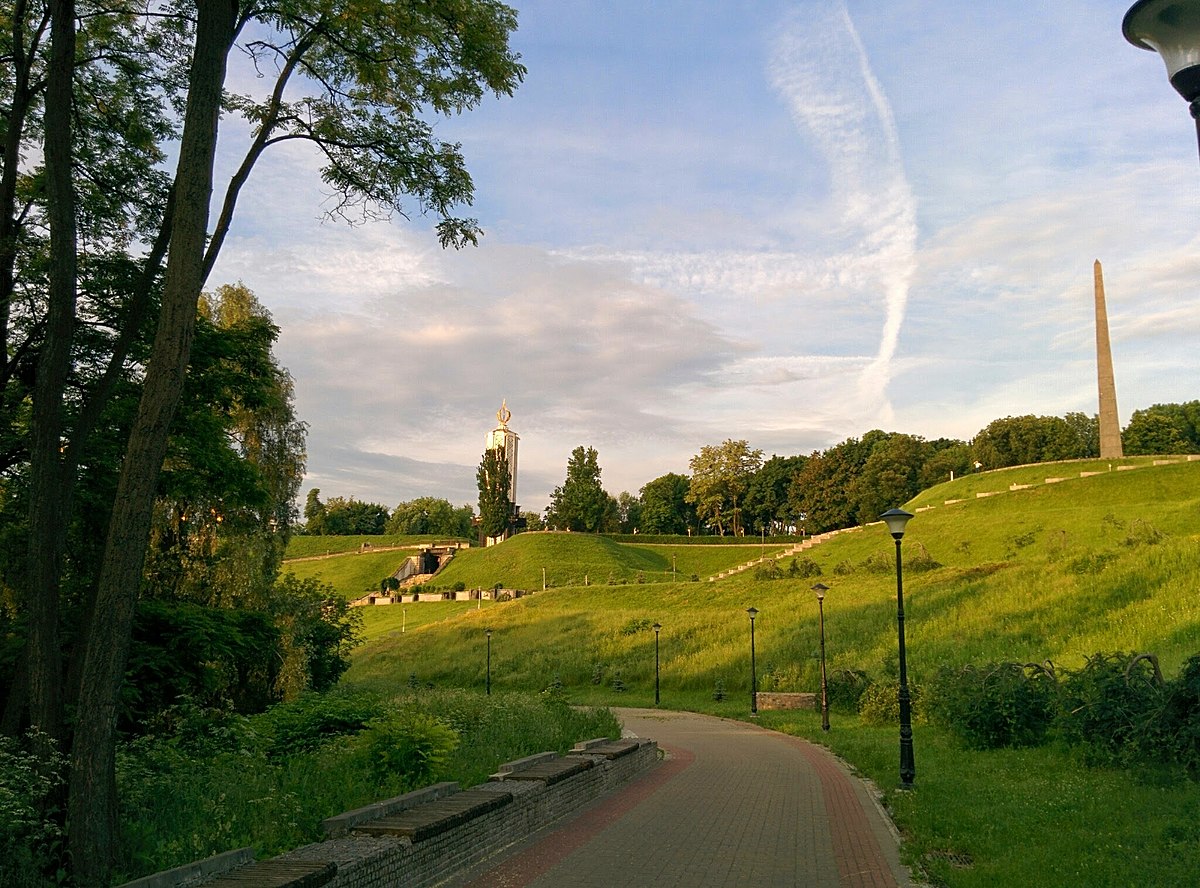The Park of Eternal Glory (former names: Anosovsky Garden, Commandant’s Garden) is located on the upper and middle terraces above the Dnieper between Lavrskaya Street and Dneprovsky Spusk. From the south it is limited by the ramparts of the old Kiev-Pechersk fortress (citadel), the lower part of the park adjoins the historical area Askold’s grave. Main entrance from Glory Square. Includes the Memorial of Eternal Glory with a monument on the tomb of the Unknown Soldier, the Memorial to the Victims of the Famine in Ukraine. The area of the park is 19 hectares.
The Park of Eternal Glory consists of two contrasting in character and skillfully interconnected parts: the upper plateau with tree and shrub plantations, from the edge of which a panorama of the Dnieper and the Left Bank opens, and a wide parterre with grassy lawns on the Dnieper slopes, lined with winding stairs leading to the lower a walking road laid along the horizontal of the relief and separated from the Dnieper descent by a curtain of trees. The arrangement of the parterre ensured the opening of the Kiev-Pechersk Lavra ensemble from the side of the descent. The park on the upper plateau is divided into a memorial (northern) part and a walking and recreation area (southern). The memorial part has a radiant planning with three alleys converging to the main entrance on Glory Square; the southern one, marked by slight differences in relief levels (remnants of the embankment of the former glacis), is a cross-shaped composition of the plan with a round glade and a flower bed in the center. The regular planning network is complemented by curvilinear paths, in particular, a view path with three rounded viewing platforms on the edge of the plateau.
History of the Park of Eternal Glory
In 1894, on the initiative and with the direct participation of the commandant of the Kiev fortress, Lieutenant-General of Artillery Anosov (hence the name – Anosovsky Garden), work began on streamlining and improvement of the site of the future park. Trees and shrubs of various species were planted, walking paths were laid, wooden walkways and pavilions were built, benches for rest were installed, a veranda with a buffet was built on the edge of the cliff, and a small fountain with a wooden pool was arranged in front of it. Funds for the creation and maintenance of the garden were allocated by the city, money was also collected from the military personnel of the Kyiv garrison and wealthy Kyivans. After Anosov left for St. Petersburg in 1899, the garden gradually fell into disrepair.
After half a century, in 1951, the territory of the park was increased to 8 hectares. In 1956, a resolution was adopted by the Council of Ministers of the USSR and the Central Committee of the Communist Party of Ukraine on the construction on this site of the Park of Eternal Glory to the soldiers of the Great Patriotic War of 1941-1945, according to which the territory was further enlarged, reconstruction and improvement were carried out. In 1957, the Memorial of Eternal Glory was solemnly opened (architect Avraam Miletsky, known for his work in Kiev as the central bus station, Salyut Hotel , Landscape alley, crematorium at Baikove cemetery, Park of Remembrance and the Wall of Remembrance at the Baikove Cemetery), to which 35 military graves from the Baikove and Lukyanovsky cemeteries, Askold’s grave, from some parks were moved to the Alley of Heroes and city squares. Military men of different ranks – from foremen to colonel-general – fought with the enemy on the territory of Ukraine, most of them distinguished themselves in the battles for Kyiv. Among them are 12 Heroes of the Soviet Union. On the occasion of the 30th anniversary of the victory over Nazi Germany (1975), the Alley of Hero Cities was formed, leading from Lavrskaya Street to the monument on the tomb of the Unknown Soldier. The trunks of the spruce trees planted at that time are surrounded by a border of polished granite, on which the names of the hero cities and the text of the dedication are laid out in superimposed bronze letters.
In 1984, on the occasion of the 40th anniversary of the liberation of Kiev from the Nazi invaders, the park was reconstructed: the design of the entrances was updated, the fences, park benches, lamps, alleys and paths were replaced, etc. The level of the Alley of Heroes has been raised by 40 centimeters, new slabs have been installed on the graves. In 1988, the ramparts and bastions of the Kiev-Pechersk citadel facing the park were partially restored: grass scarps were restored, straight granite steps were laid on the valgang of the Spassky bastion. Landscaping of the territory was carried out with clearing of the wild vegetation of the Dnieper slopes and with the organization of observation zones and platforms. By 2000, the middle Nadneprovskaya terrace attached to the park was streamlined, where a walking path was laid from Askold’s grave to the walls of the Lavra; in front of the main entrance to the park from the side of Glory Square, a new paving of a round forecourt was made; the upper and lower terraces of the park are connected by granite stairs. Opposite Askold’s grave, at the expense of the Public Fund of St. Andrew the First-Called, a chapel in honor of the 2000th anniversary of the Nativity of Christ was built. In 2001, a park sculpture dedicated to military pilots.
On May 9, 2010, at the end of the left side of the Alley of Hero Cities, a monument to the pilot I. Kozhedub was unveiled. It is assumed that the monument to I. Kozhedub will become the beginning of the Alley of Military Glory. On May 22, 2012, the Verkhovna Rada adopted a resolution on its creation. “The alley will immortalize the names of the heroes who were born in Ukraine and took part in the fighting for the liberation of Ukraine. It should become a work of art, which would contribute to both education and perpetuation of memory. The idea of the project is not to go beyond the Great Patriotic War,” said the chairman of the organizing committee for the creation of the Alley. On May 1, 2013, busts of G. Beregovoy and S. Amet-Khan were unveiled on the Alley, on September 21, 2013 – S. Kovpak and A. Fedorov, and on November 5, 2013 – P. Rybalko and I. Chernyakhovsky.
Both parts are planted and landscaped: in the memorial part there are green hedges made of sheared hornbeam and rhythmically planted firs along the Alley of Hero Cities and paving with gray granite slabs; in the south – the free placement of trees and shrubs and the covering of alleys and paths with modern curly paving elements (the so-called fems). The low fence of the park is made up of granite blocks with a bush-hammered surface. Along the alley, parallel to Lavrskaya Street, and on the southern lawn, semicircular benches for rest were installed (a brick base with wooden slats for sitting). Lighting lanterns are made in the form of low vertical cylinders made of metal and plexiglass (in the upper part). At the foot of the Spassky bastion of the Kiev-Pechersk citadel and not far from the Askold’s grave, playgrounds are equipped.
The landscapes of the park are picturesque. Norway maple, silvery sycamore, linden, birch, elm, poplar, spruce, willow, pyramidal oak, and other tree species grow here; shrubs – amphora, jasmine, lilac, spirea, tamarisk, forsythia and many others. The Park of Eternal Glory is one of the best upland parks in Kyiv.
Where is the Park of Eternal Glory located?
Glory Square (main entrance)


